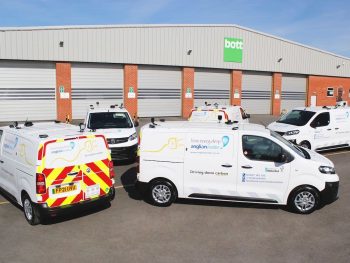Anglian Water has deployed 33 extra electric vans on its fleet with a further 43 due by the end of the year.

The new Vauxhall Vivaro-e vans bring the firm’s total fleet of EVs to 86 and Anglian Water expects to add a further 130 EVs next year.
The electric vans boost the company’s work to achieve net zero by 2030. It’s also reviewed its car policy and is implementing 32 electric cars on its fleet – with the total expected to exceed 60 by the end of the year.
Head of fleet Mick Farmer said: “As one of the largest energy users in the East, it’s our responsibility to do all we can to minimise our impact on the environment and growing our electric vehicle fleet is a great step for us in doing so.
“Increasing our fleet of electric vehicles provides us with the opportunity to utilise more renewable and sustainable technology, helping to make a positive impact on our region’s environment, and reach the industry’s ambition to reach net zero by 2030.”
The new vans, which have been converted by Bott, will be used across the company by Anglian Water front-line engineers. Its van fleet currently cover 20 million miles on the road each year and the company spends more than £4.5m on diesel annually.
Mick Farmer continued: “Extensive analysis of telematics data has identified large numbers of vans that meet a set criteria for operational teams to transition to electric vehicles. We will now be working even closer with these teams once the new vans have been deployed to help us identify any additional challenges other operational teams are facing. This analysis will enable us to create our next EV plan, enhancing our transition as we expand the fleet further.”
Anglian Water has also installed additional electric charging points across a number of its sites.
The electric van conversions by Bott included work to reduce the impact of electrical accessories on vehicle performance and range.
Bott managing director Kevin Woodward explained: “With our own investigations, and working closely with Vauxhall, we have built in a combination of manual and automatic regulation of the auxiliary electrical system. This keeps the user working effectively without exceeding any manufacturer-recommended limits.”

